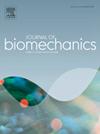Test-retest reliability of a dance-specific jump test using wearable technology among university contemporary dancers
IF 2.4
3区 医学
Q3 BIOPHYSICS
引用次数: 0
Abstract
A dance-specific jump test utilizing inertial measurement units (IMUs) to determine limb symmetry indices (LSI) may prove useful for clinicians responsible for dancer populations.
The aim of this study was to determine test–retest reliability of a dance-specific jump test using wearable technology to capture limb asymmetry in university contemporary dancers. Nineteen female undergraduate dance majors participated in two testing sessions one week apart. IMUs (Vicon Motion Systems, UK) were attached to the distal anteromedial aspect of each tibia and at the L5/S1 joint. Participants performed three jumps: countermovement jump (CMJ), a single leg side hop (SH), and a dance-specific jump (DSJ). Test-retest reliability of asymmetry measures [i.e., peak impact acceleration (g), mean asymmetry (%)] and performance measures [i.e., flight time (sec), time to completion (sec), and jump height (cm)] were estimated using intraclass correlation coefficients [ICCs (95% CI)] and Bland Altman methods of agreement [95% limits of agreement (LOA)]. For asymmetry measures, reliability was poor for CMJ [ICC 0.36 (95% CI −0.08–0.77)], moderate for SH [ICC 0.66 (95% CI 0.35–0.88)] and good for DSJ [ICC 0.82 (95% CI 0.49–0.94)]. Wide 95% LOA were demonstrated for all jumps. For performance measures, moderate to good reliability and acceptable LOA were found for all jumps. While a lack of agreement was found for asymmetry measures, sufficient reliability and acceptable agreement were established for performance measures for all jump tests in university contemporary dancers. This method may be used to monitor the performance of jumps and jump load throughout a training season.
求助全文
约1分钟内获得全文
求助全文
来源期刊

Journal of biomechanics
生物-工程:生物医学
CiteScore
5.10
自引率
4.20%
发文量
345
审稿时长
1 months
期刊介绍:
The Journal of Biomechanics publishes reports of original and substantial findings using the principles of mechanics to explore biological problems. Analytical, as well as experimental papers may be submitted, and the journal accepts original articles, surveys and perspective articles (usually by Editorial invitation only), book reviews and letters to the Editor. The criteria for acceptance of manuscripts include excellence, novelty, significance, clarity, conciseness and interest to the readership.
Papers published in the journal may cover a wide range of topics in biomechanics, including, but not limited to:
-Fundamental Topics - Biomechanics of the musculoskeletal, cardiovascular, and respiratory systems, mechanics of hard and soft tissues, biofluid mechanics, mechanics of prostheses and implant-tissue interfaces, mechanics of cells.
-Cardiovascular and Respiratory Biomechanics - Mechanics of blood-flow, air-flow, mechanics of the soft tissues, flow-tissue or flow-prosthesis interactions.
-Cell Biomechanics - Biomechanic analyses of cells, membranes and sub-cellular structures; the relationship of the mechanical environment to cell and tissue response.
-Dental Biomechanics - Design and analysis of dental tissues and prostheses, mechanics of chewing.
-Functional Tissue Engineering - The role of biomechanical factors in engineered tissue replacements and regenerative medicine.
-Injury Biomechanics - Mechanics of impact and trauma, dynamics of man-machine interaction.
-Molecular Biomechanics - Mechanical analyses of biomolecules.
-Orthopedic Biomechanics - Mechanics of fracture and fracture fixation, mechanics of implants and implant fixation, mechanics of bones and joints, wear of natural and artificial joints.
-Rehabilitation Biomechanics - Analyses of gait, mechanics of prosthetics and orthotics.
-Sports Biomechanics - Mechanical analyses of sports performance.
 求助内容:
求助内容: 应助结果提醒方式:
应助结果提醒方式:


